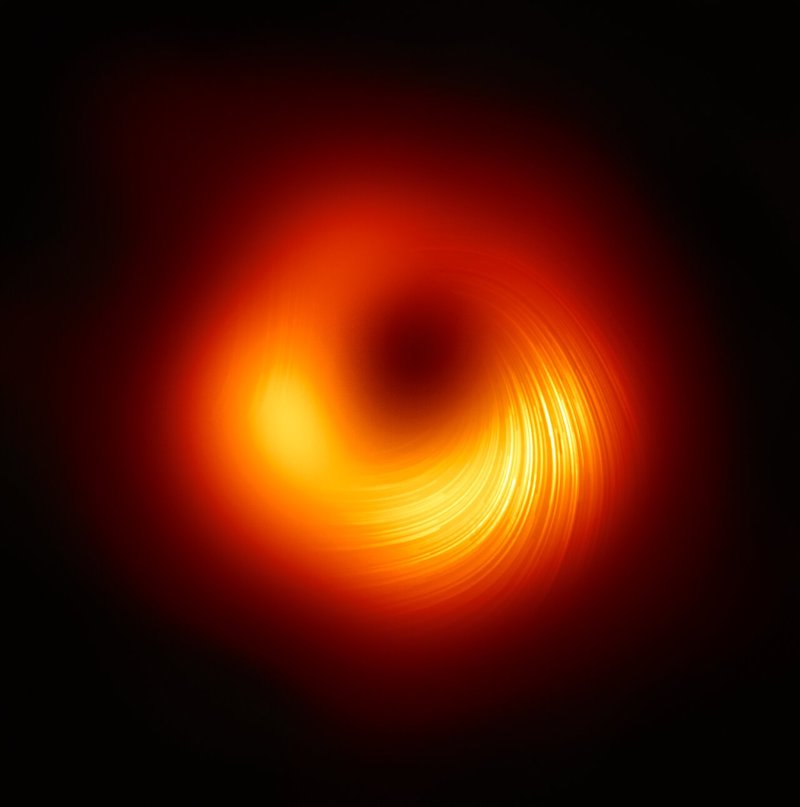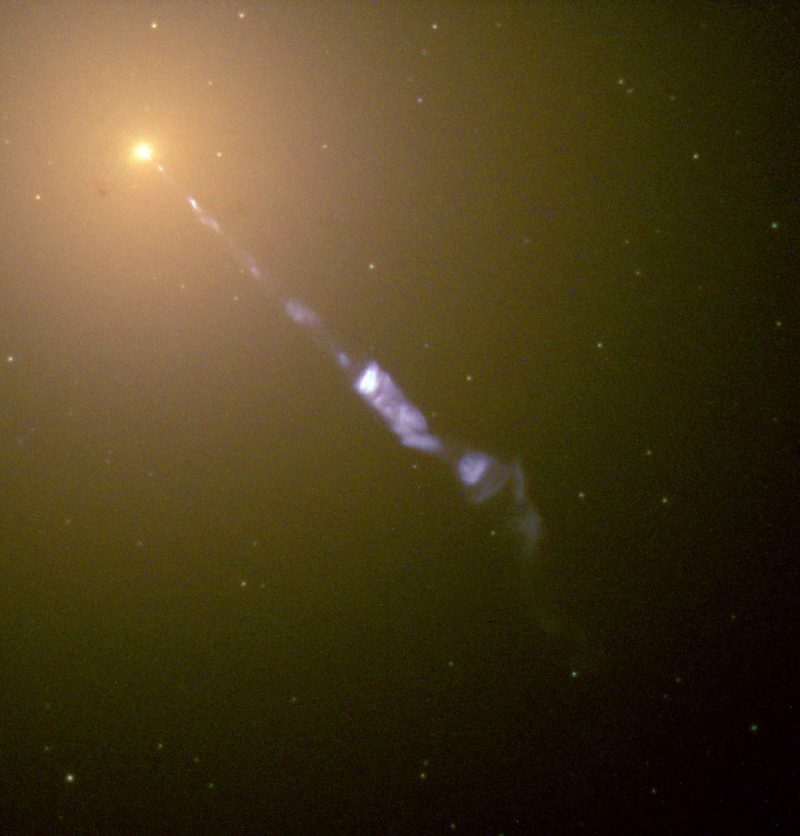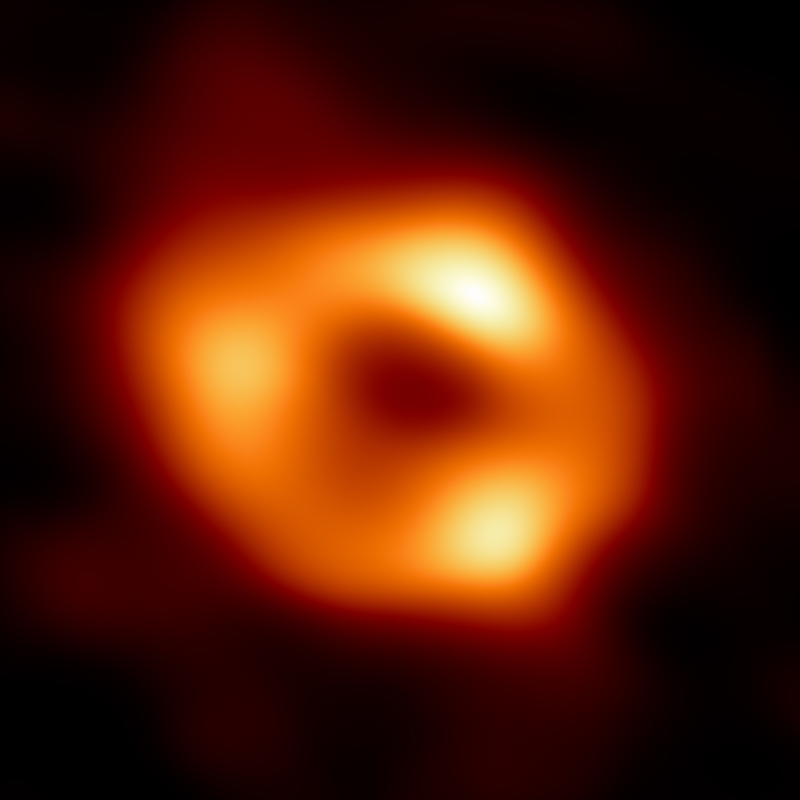
- Astronomers used the Event Horizon Telescope to capture the first polarized light image of the Milky Way’s supermassive black hole, Sagittarius A*.
- This breakthrough suggests that all black holes may possess strong magnetic fields, challenging previous understanding.
- The image also hints at the presence of a hidden jet emanating from the Milky Way’s black hole. Wow!
1st image of Milky Way’s black hole in polarized light
The Milky Way’s supermassive black hole – dubbed Sagittarius A* (pronounced Sagittarius A-star) – lies behind vast dust and star clouds. So most of what we know about this monster black hole comes from radio wavelengths, which can penetrate dust. But today – March 27, 2024 – we know a little more about the Milky Way’s black hole. Astronomers just announced that they used the Event Horizon Telescope to capture the first image of our galaxy’s giant black hole in polarized light. This is the same telescope used to capture the 1st-ever direct image of a supermassive black hole in 2019. The new image suggests all black holes may have strong magnetic fields. It also hints that our galaxy’s black hole might harbor a hidden jet. Wouldn’t that be something?!
The Event Horizon Telescope takes its name from the border of a black hole, what scientists call the event horizon, because we can’t see anything that happens beyond that boundary.
The team of scientists published their new peer-reviewed research in two papers in The Astrophysical Journal Letters on March 27, 2024.
The black hole at the Milky Way’s core
Black holes have such strong gravity that nothing can escape … not even light. That’s why we call them black holes. The supermassive black hole at the Milky Way’s center has the mass of 4 million suns. But it contains all this mass in the space of only about 8 suns lined up. That’s a whole lot of mass in a tight space.
When we say the astronomers looked at polarized light from the black hole, remember that the whole electromagnetic spectrum is considered light. That includes the visible light at the middle of the spectrum all the way to both ends, from radio waves to gamma rays. So the radio waves they look at are also referred to as light, even though it’s not the visible light we think of.
Radio waves reach us from the Milky Way’s center
By examining the immediate environment of a black hole in radio waves, we can learn more about these invisible monsters. The new observations from the Event Horizon Telescope show strong, organized magnetic field lines spiraling away from the black hole’s edge. These look similar to what researchers first found coming from the galaxy M87 in 2021. The magnetic fields around M87’s central black hole have helped scientists better understand what powers that galaxy’s famous jets. And the new research hints that the Milky Way may also have a hidden jet.
Sara Issaoun, NASA Hubble Fellowship Program Einstein Fellow at the Center for Astrophysics | Harvard & Smithsonian and co-leader of the project, said:
What we’re seeing now is that there are strong, twisted and organized magnetic fields near the black hole at the center of the Milky Way galaxy. Along with Sgr A* having a strikingly similar polarization structure to that seen in the much larger and more powerful M87* black hole, we’ve learned that strong and ordered magnetic fields are critical to how black holes interact with the gas and matter around them.
Polarized light from the Milky Way’s black hole
Sometimes these electromagnetic waves that we call light oscillate in a specific orientation. That’s called polarization. When light whirls around black holes, it becomes polarized perpendicular to the magnetic field lines. So observations of the polarized light let astronomers map a black hole’s magnetic field lines.
Angelo Ricarte, a Harvard Black Hole Initiative Fellow and project co-leader, said:
By imaging polarized light from hot glowing gas near black holes, we are directly inferring the structure and strength of the magnetic fields that thread the flow of gas and matter that the black hole feeds on and ejects. Polarized light teaches us a lot more about the astrophysics, the properties of the gas, and mechanisms that take place as a black hole feeds.
But the polarized light around the supermassive black hole acts like an overactive child who doesn’t want to sit still for a photograph. So this image presented a real challenge. Geoffrey Bower from the Institute of Astronomy and Astrophysics, Academia Sinica, Taipei, said:
Because Sgr A* moves around while we try to take its picture, it was difficult to construct even the unpolarized image. We were relieved that polarized imaging was even possible. Some models were far too scrambled and turbulent to construct a polarized image, but Nature was not so cruel.
A possible jet?
The polarized image from M87’s black hole and the new one from the Milky Way’s black hole look quite similar. Mariafelicia De Laurentis, EHT Deputy Project Scientist and professor at the University of Naples Federico II, Italy, said:
With a sample of two black holes — with very different masses and very different host galaxies — it’s important to determine what they agree and disagree on. Since both are pointing us toward strong magnetic fields, it suggests that this may be a universal and perhaps fundamental feature of these kinds of systems. One of the similarities between these two black holes might be a jet, but while we’ve imaged a very obvious one in M87*, we’ve yet to find one in Sgr A*.
First black hole image
It wasn’t until 2019 that we got our first image of a black hole. That was the supermassive black hole at the center of galaxy M87. The Event Horizon Telescope also captured that image. So, in the image below, the ring of light you see is glowing gas swirling around the black hole, while the dark center is called the black hole’s shadow. You can’t see the black hole itself, of course, because light can’t escape.
M87’s supermassive black hole makes ours seem wimpy in comparison. The black hole at the core of M87 is 6.5 billion times more massive than our sun. Meanwhile, the Milky Way’s central black hole is a mere 4 million times more massive than our sun.

First black hole image in polarized light
Then, in 2021, astronomers – again with the help of the Event Horizon Telescope – were able to image the black hole in M87 in polarized light. Light gets polarized when it travels through hot regions where magnetic fields are present. So, the polarized image of the black hole’s region allows astronomers to map the magnetic field lines near the event horizon. And the magnetic field lines tell astronomers how black holes consume matter and launch powerful jets. The jet coming from M87 is the galaxy’s most distinctive feature.


First ever image of the Milky Way’s black hole
Finally, in 2022, we got our first view of the Milky Way’s supermassive black hole. Its appearance echoed that of the supermassive black hole around M87.

Bottom line: Scientists using the Event Horizon Telescope have imaged the polarized light from our Milky Way’s black hole for the first time. This light allows us to learn about the magnetic field lines around the black hole and suggest there could be a hidden jet.
Sources:
First Sagittarius A* Event Horizon Telescope Results. VII. Polarization of the Ring











